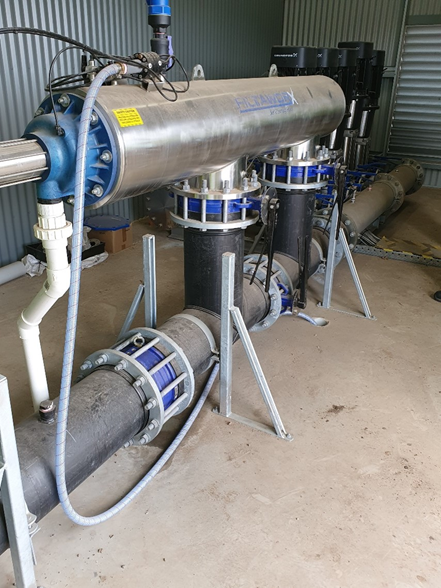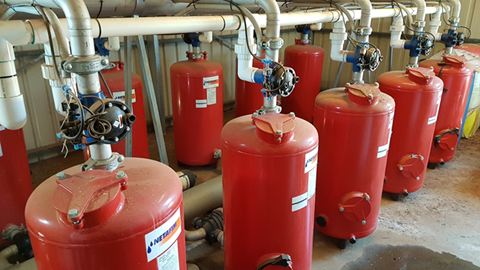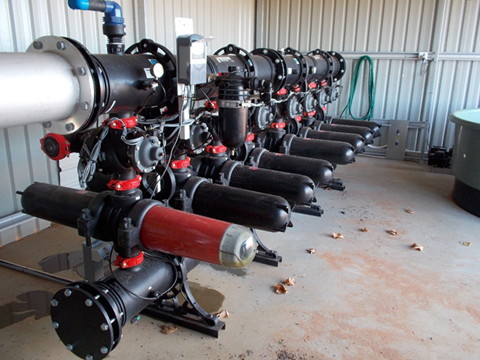Filtration is an essential component of some irrigation methods and a crucial part of drip irrigation systems. Besides being an expensive investment at first, it pays off by:
- Reducing debris and other contaminates entering the system.
- Avoiding blockages.
- Extending the life of the system.
- Lowering labour costs and work time.
- Ensuring system effectiveness.
- Supporting efficient water delivery to crops.
Before purchasing equipment, you must know your needs and the different filtration options and talk to your irrigation designer and equipment supplier.
Let’s go ahead and dive into the different filter types and their advantages and disadvantages to suit a particular farm’s situation.
Screen filters
Screen filters provide surface filtration and are usually made of metal, plastic, or synthetic cloth enclosed in a special housing. Screen filters are referred to by their mesh size and there are a range of mesh sizes suited to particular situations.

Figure 1. Typical screen filter – photo: John Harvie
| Advantages | Disadvantages |
|
· Low head loss. · Smaller installation area when compared to media filters. · Lower cost for a given flow. |
|
| Backflush: Automated suction scanners can clean screen filters without interrupting the filtration process. The self-cleaning cycle can be scheduled on a time interval or triggered by a pressure differential when debris accumulates on the inner screen. | |
Media filters
In areas where dirty water is used, media filters are generally the most popular choice, given the high filtration degree it can provide.
Filtration is three-dimensional, with the total filter area being the product of each tank’s width, height, and depth. Multiple filtering layers are possible, ensuring that as many particles are trapped as possible.

Figure 2. Bank of media filters – photo: John Harvie
| Advantages | Disadvantages |
|
· Considered the most reliable filtration method. · Provides various sizes of filtration particles. |
|
| Backflush: Media filters are always backflushed in sequence, either at a set time interval or whenever the media becomes dirty enough to create a significant pressure differential between the tank inlet and outlet. Usually, one filter for backflushing is added to the number of filters needed to service the field. Two-tank systems are notorious for having problems during backflushing: the problems occur where there is not enough flow available to backflush properly and irrigate the field at the same time. | |
Disc filters
Described as a hybrid of screen and media filters, disc filters have a series of grooved rings, forming a cylindrical filter with each groove crossing the other in different directions, creating a three-dimensional matrix of pathways. Different grades of filtering are achieved by varying the size of the grooves (usually specified by a particular disc colour), thereby representing an equivalent grade of filter mesh.

Figure 3. Disc Filters – photo: John Harvie
| Advantages | Disadvantages |
|
· Smaller backflushing volumes · Smaller installation areas |
|
| Backflush: For primary filtration, disc filters are automatically flushed with a series of internal jets. During backflushing, the discs are separated, water flow is reversed through multi-jet nozzles, the discs spin, and dirt is removed from the discs. | |
Secondary filtration
Secondary filtration (back-up or check filters) serves as a backup to protect emitters from large amounts of dirt that can enter from breaks in the mainline, or small particles that were not removed by primary filtration which could aggregate to form larger particles, or growths within the system. Secondary filtration is generally designed to remove larger material (200 µ), therefore their mesh grade is usually one grade coarser, than the primary filters.
For further information on filtration for drip irrigation systems visit Agriculture Victoria.
This publication is provided solely for information purposes and no representation or warranty is made as to its quality, accuracy, completeness, suitability, or fitness for any particular purpose. You should make your own enquiries as to its appropriateness and suitability for your particular circumstances. The State of Victoria as represented by its Department Energy, Environment and Climate Change accepts no duty of care and disclaims all liability in relation to use of this publication.
